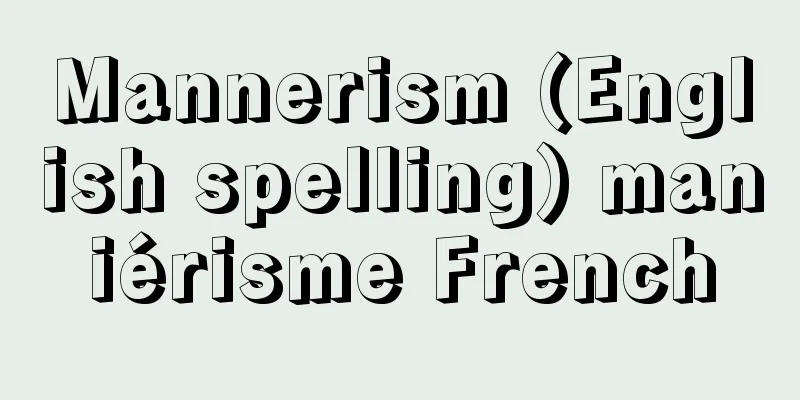Mannerism (English spelling) maniérisme French

|
Mannerismo in Italian, Mannerism in English. The word originates from the Italian word maniera, which means technique or style. In general, it refers to a passive attitude of following existing techniques and forms conventionally and repeatedly and skillfully without originality, and the term Mannerism is widely used. However, in recent years, it has attracted attention as a specific stylistic concept for artistic phenomena in Europe from the High Renaissance to the Baroque, and its importance has been emphasized. The dates of Mannerism as an artistic style vary by region and field, but generally span from around 1520 to around 1600. Until the beginning of the 20th century, the art of this period was considered to be merely a stagnant style that merely imitated the classical art of the Renaissance in a technical sense, but subsequent research has led to a reevaluation of it as an independent art form distinct from the High Renaissance. Europe in the 16th century was in a time of great unrest and anxiety in all aspects of society and thought, including religion, science, politics, and economics, and was facing a spiritual crisis. In particular, Italy, which has played a leading role in the literary revival since the previous century, has typically reflected this in the development of art. In reaction to the normative ideal beauty that values harmony, balance, and stability, it has strengthened its tendency toward subjectivism, which can be said to be intellectual, ignoring imitation of nature. Influenced by the later works of Raphael and Michelangelo, the style is characterized by sophisticated technique, complex spatial composition, distorted perspective, and strong chiaroscuro, as well as fantastical allegorical expressions, abnormally distorted proportions, depictions of intense movement, and dazzling, unrealistic colors. Its development, centered on painting, is usually divided into three stages. The first period (c. 1520-1540) saw the work of Pontormo, Rosso Fiorentino, Parmigiano, and Beccafumi (1485/1486-1551). The second period (c. 1540-1570) saw the work of Bronzino, Vasari, sculptor Benvenuto Cellini, and architects Vignola and Palladio. Around this time, Italian Renaissance art spread throughout Europe as court art, and Mannerism also spread as an international style. The establishment of the School of Fontainebleau in France is included in this period. The third period (c. 1570-1610) saw the work of painter Tintoretto and sculptor Giambologna (1529-1608). The Spanish painter El Greco can also be mentioned. In addition to these artists from the Netherlands, Mannerism encouraged the activities of many other artists under the patronage of the courts of Prague, Vienna, Munich, etc. This art style, which initially moved from anti-classical aestheticism through courtly academicism to a rigid eclecticism, eventually gave way to the Baroque with the rise of anti-Mannerism, which was rooted again in the affirmation of realistic nature and the elevation of human life. [Kamihira Mitsugu] "Mannerism" by A. Hauser, translated by Midori Wakakuwa (1970, Iwasaki Bijutsusha)" ▽ "The Establishment of Mannerism and Baroque" by W. Friedlander, translated by Minoru Saito (1973, Iwasaki Bijutsusha)" ▽ "A Theory of Mannerist Art" by Midori Wakakuwa (1980, Iwasaki Bijutsusha) Source: Shogakukan Encyclopedia Nipponica About Encyclopedia Nipponica Information | Legend |
|
イタリア語でマニエリズモ、英語でマナリズム。手法・様式を意味するイタリア語のマニエラmanieraを語源とする。一般には、既成の手法や形式を慣習的に踏襲して、独創性のないままに繰り返し器用に処理しようとする消極的態度をさすことばで、いわゆるマンネリズムの用語が流布している。しかし近年、ヨーロッパの盛期ルネサンスからバロックに至る間の芸術現象に対する特定の様式概念として注目され、その重要性が強調される。 芸術様式としてのマニエリスムの年代は、地域や芸術分野により差違があるが、ほぼ1520年ごろから1600年前後に及ぶ。20世紀の初めまで、この時代の芸術はルネサンスの古典的芸術を技巧的に模倣しただけの沈滞期の様式を示すにすぎないとみられていたが、その後の研究で盛期ルネサンスと異なる独立した芸術として再評価を受けるに至った。16世紀のヨーロッパは、宗教や科学、政治や経済など、社会や思想のあらゆる面から大きな動揺と不安の時代を迎え、精神的危機に直面していた。とくに前世紀以来、文芸復興の主導的役割を果たしたイタリアでは、それらを典型的に美術発展に反映している。調和・均衡・安定を重んじる規範的理想美に対する反発から、自然の模倣を無視して主知的ともいえる主観主義の傾向を強めていく。ラファエッロの晩年やミケランジェロの後期作品の影響も受けて、その様式は、洗練された技巧に加え、錯綜(さくそう)した空間構成、ゆがんだ遠近法、強い調子の明暗法を駆使して、幻想的な寓意(ぐうい)的表現、異常なまでにゆがめられたプロポーションや激越な運動感の描出、幻惑するような非現実的色彩法などをその特色とする。絵画を中心とするその発展は、普通、次の3段階に分けられる。 第1期(1520ころ~1540ころ)はポントルモ、ロッソ・フィオレンティーノ、パルミジアニーノ、ベッカフーミBeccafumi(1485/1486―1551)らの活躍。第2期(1540ころ~1570ころ)はブロンツィーノ、バザーリ、彫刻のベンベヌート・チェッリーニ、建築ではビニョーラ、パッラディオら。このころイタリアのルネサンス美術がヨーロッパ全域の宮廷芸術に浸透したのに続いて、マニエリスムも国際様式として伝播(でんぱ)していった。フランスのフォンテンブロー派の成立はこの期に含まれる。第3期(1570ころ~1610ころ)には絵画のティントレット、彫刻のジャンボローニャGiambologna(1529―1608)など。またスペインの画家エル・グレコもあげられる。このほかネーデルラント出身者をはじめ、プラハ、ウィーン、ミュンヘンなどの各宮廷の庇護(ひご)のもとにマニエリスムは多くの芸術家の活躍を促した。当初の反古典的唯美主義から宮廷的アカデミズムを経て、しだいに硬直化した折衷主義へと移行したこの美術様式は、やがてふたたび現実的自然の肯定と人間生命の高揚に根ざした反マニエリスムの台頭によって、バロックへその道を譲ることになった。 [上平 貢] 『A・ハウザー著、若桑みどり訳『マニエリスム』全三巻(1970・岩崎美術社)』▽『W・フリートレンダー著、斎藤稔訳『マニエリスムとバロックの成立』(1973・岩崎美術社)』▽『若桑みどり著『マニエリスム芸術論』(1980・岩崎美術社)』 出典 小学館 日本大百科全書(ニッポニカ)日本大百科全書(ニッポニカ)について 情報 | 凡例 |
<<: Manicure - Manicure (English spelling)
Recommend
Bleaching - Hyohaku (English spelling)
Bleaching refers to the process of chemically brea...
Arnulf von Metz
He was the teacher of Dagobert I from around 580 t...
Coarse flour - Arako
…The corms are processed into edible konnyaku, an...
National Examination - Kokuken
Abbreviation of Kokuga Kenchu or Kokushi Kenchu....
Optical mode
...This is because high-frequency lattice vibrati...
Appeldern, A.von (English spelling) AppeldernAvon
… [history] Riga was once the homeland of the Fin...
Water strider - Water strider (English spelling)
An insect of the Hemiptera family, Water strider f...
Amateur theatre - amateur theatre
In contrast to professional theater, it generally ...
Kususan (Camphor silkworm) - Kususan (English spelling) Dictyoploca japonica
An insect of the Lepidoptera family, Saturniidae (...
Gaya (English spelling)
A city in the mid-west of Bihar, northeast India. ...
Electro-electret
…Electrets are classified according to the method...
Ministry of Imperial Command - Chokushisho
An extra-official government system established du...
Gowon, Y.
...However, immediately after the promulgation of...
Tsukiige - Tsukiige
A thorny perennial grass of an unusual shape that ...
Red face - Red face
…(2) Villain/Court Evil: Hara-dashi and Uke in Sh...









